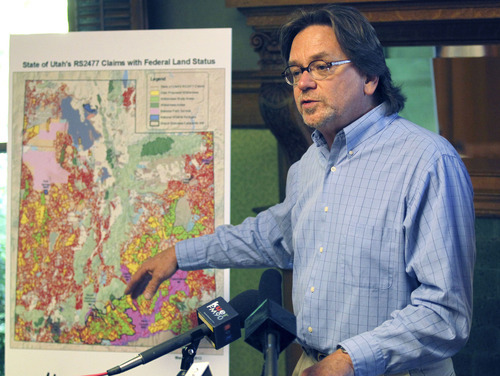This is an archived article that was published on sltrib.com in 2012, and information in the article may be outdated. It is provided only for personal research purposes and may not be reprinted.
Utah's threatened court fight for control of 25,000 routes crossing federal lands isn't really about roads, critics say, it's about blocking federal protection of wild places.
The Southern Utah Wilderness Alliance unveiled a map Tuesday showing a tangle of 45,000 miles of purported historic routes that slice up wilderness study areas and places that could qualify as wilderness.
Federal law used to grant road rights wherever the public had created "highways." That ended in 1976, leaving courts to decide which routes might be legitimate claims, and what's wishful thinking.
"What we're talking about today are roads to nowhere," SUWA attorney Heidi McIntosh said, "except that they aren't even really roads."
Utah Association of Counties attorney Mark Ward insists the roads are real — and "most definitely about transportation."
"Every road to be claimed in the upcoming state and county lawsuits are decades old, legitimate and well-established public transportation routes," Ward said, "on which a broad cross section of Utahns and Americans depend for access, law enforcement, recreation, resource use and resource preservation."
Opponents countered by presenting photos of routes — one a rocky crevice in Capitol Reef National Park, another a light desert imprint that McIntosh likened to a "game trail" — to argue that many are nothing more than one Jeep driver's whim.
SUWA doesn't dispute so-called Class B roads in the claims. Those roads are graded and maintained. But the group opposes something a single pickup or all-terrain vehicle might have pioneered. The maintained roads constitute about 2,000 of the 25,000 claims the state and several southern Utah counties have made.
The state, with Gov. Gary Herbert's backing, filed notice of intent to sue over the bulk of the claims last year and is expected to file the formal complaint this summer.
The time for action is now, Herbert public lands adviser John Harja said, partly because a 12-year limit linked to a state letter claiming these roads during the Clinton administration expires June 14. But with the state having to prove, one by one, that each road segment was in use before 1976, there's also a pressing need to present evidence soon.
"The witnesses are all getting old," he said, "starting to pass on and get infirm. From our perspective, it's time to get going."
Several conservation groups and outdoor-gear maker Black Diamond joined SUWA on Tuesday in calling the suit — and similar claims by San Juan, Kane and Garfield counties — a threat to wildlife, archaeological treasures and Utah's internationally renowned red-rock experience.
Using state data from records requests, SUWA created a map showing disputed roads nearly blotting out Bureau of Land Management turf in San Juan and Grand counties, along with 4,500 routes extending through 9 million acres of BLM-managed wilderness study areas or wilderness-quality remote areas that would be preserved by a SUWA-backed congressional proposal.
The claims also would send road tendrils through the Grand Staircase-Escalante National Monument and Capitol Reef National Park. McIntosh said accepted dirt roads and switchbacks crossing those areas offer vehicular "adventures" that would be lost if the state got its way and could grade or pave a 66-foot right of way.
The National Parks Conservation Association, the Colorado Plateau Archaeological Alliance, the Sierra Club and the Wild Utah Project all joined in asserting that the road claims would harm Utah's outdoor-recreation economy, its deer and elk herds and its remote archaeological sites.
Some of the routes, including one in Emery County that stretches past ancient American Indian sites in lower Range Creek, would bring looters and vandals to scientific and cultural treasures, said Jerry Spangler, who directs the archaeology group.
Black Diamond CEO Peter Metcalf warned if traffic on remote roads ruins Utah's famous solitude, it also will wreck the support industry that employs 65,000.
But Harja said these roads are all about the economy. Whether originally pioneered for hay hauling, recreation, mining or drilling, he said, they enable jobs.
"It's the transportation network," he said, "which is what keeps the economy going."
Twitter: @brandonloomis









